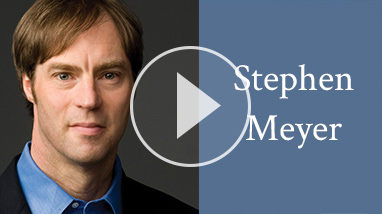


James Tour and Stephen Meyer on the Origin of Life, Pt. 1
On this episode of ID the Future, James M. Tour and Stephen C. Meyer begin a discussion about the hard problems facing researchers trying to discover how the first life could have come about naturalistically. Meyer is the director of the Center for Science and Culture; Tour is a world-renowned synthetic organic chemist with over 700 research publications and multiple major recognitions, including TheBestSchools.org naming him one of the 50 most influential scientists in the world today. Though he doesn’t sign on to ID theory, he says he’s sympathetic with the idea, and certainly not impressed with any naturalistic explanations for the origin of life. In this first of a three-part series, they explore problems ranging from the extreme improbabilities associated with protein assembly, Read More ›

New Origin-of-Life Proposal Revives a Hopeful Monster
On this episode of ID the Future, host Eric Anderson talks with scientist and fellow engineer Rob Stadler about a recent origin-of-life paper and how the authors paint themselves into a corner. The context for the paper is this: Decades of research have undermined the three great hopes for a purely naturalistic origin of life — scenarios starting with some sort of metabolism, scenarios starting with some kind of membrane, and scenarios starting with RNA. All three are necessary for cellular life; none seems able to have come ahead of the others. So now some recent work described in an article in New Scientist suggests it all happened at once in a sort of “chemical big bang.” It’s the return Read More ›

The Origin of Life and the Materialism of the Gaps
On this episode of ID the Future, host Eric Anderson speaks again with medical engineer Rob Stadler, co-author with molecular biologist Change Laura Tan of the new book Stairway to Life: An Origin of Life Reality Check. Here in Part 2 of their conversation, Stadler says that following the Miller-Urey experiments in the mid-twentieth century, researchers were optimistic that a purely naturalistic explanation for the origin of the first life was just around the corner, but since then the field has run into one obstacle after another. The challenge to mindless origin-of-life scenarios is now far greater than it was 60-70 years ago. And yet many in the field still cling to the belief that life must have arisen by Read More ›

New Book: The Stairway to Life Is Really a Cliff
On this episode of ID the Future, guest host Eric Anderson speaks with medical engineer Rob Stadler, co-author with molecular biologist Change Laura Tan of the new book Stairway to Life: An Origin of Life Reality Check. Read More ›

Paul Nelson on Freeing Minds Trapped in a Naturalistic Parabola
On this episode of ID the Future, philosopher of science Paul Nelson continues sharing with host Andrew McDiarmid about pursuing intelligent design theory in a science culture committed to naturalism. Read More ›

New ID Book Zeroes in on Evolution’s Zero-Probability Problem
On this episode of ID the Future, Andrew McDiarmid concludes his conversation with Eric Anderson, one of the co-authors of the new Discovery Institute Press book Evolution and Intelligent Design in a Nutshell. Today they talk about Anderson’s second of two chapters in the book, where he explores the challenges of building a self-replicating 3D printer, and the light this sheds on the origin-of-life community’s search for their Holy Grail, a self-reproducing molecule that could have kickstarted the evolutionary process on the early earth. In their conversation, Anderson suggests that there are engineering principles involved in the origin of life that may mean that a naturalistic origin of life is less like winning a long-odds lottery, and more like the Read More ›

New ID Book Puts “Self-Replicating Molecules” Under the Microscope
On this episode of ID the Future, Andrew McDiarmid interviews Eric Anderson, one of the co-authors of the new book Evolution and Intelligent Design in a Nutshell. The two discuss Eric’s chapters on the origin-of-life problem. There’s the problem of generating the information required of the first life form. And there’s another problem, one Anderson uses his engineering background to explore — the insuperable challenges to generating a self-replicating molecule, a hypothetical entity at the heart of some recent attempts to render plausible the evolution of non-life into cellular life.

Cosmos: Possible Worlds’ ‘Most Plausible’ Creation Myths
On this episode of ID the Future, philosopher Jay Richards hosts science historian Michael Keas in another conversation about Neil deGrasse Tyson’s series Cosmos: Possible Worlds. They talk this time about what the show itself calls its “most plausible creation myth… for the origin of life,” involving hydrothermal vents in the deep ocean floor — with no mention at all of the equally deep scientific problems with the idea. Tyson’s imagination wanders from there to a moon of Saturn to the Cambrian explosion, everywhere supposing that just because one or two necessary conditions exist for life, that’s all the explanation that’s needed. Richards and Keas ably explore why this is untrue.

Dr. Stephen Meyer: What is the key thing to be explained in origin of life research?
Stephen Meyer explains the basis for his new book Darwin’s Doubt: The Explosive Origin of Animal Life and the case for Intelligent Design (HarperOne, June 18, 2013). For more information on the book and to order your copy visit http://www.darwinsdoubt.com